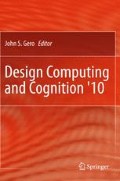Abstract
Designed artefacts may be quantified by any number of measures. This paper aims to show that in doing so, the particular measures used may matter very little, but as many as possible should be taken. A set of building plans is used to demonstrate that arbitrary measures of their shape serve to classify them into neighbourhood types, and the accuracy of classification increases as more are used, even if the dimensionality of the space in which classification occurs is held constant. It is further shown that two autonomous agents may independently choose sets of attributes by which to represent the buildings, but arrive at similar judgements as more are used. This has several implications for studying or simulating design. It suggests that quantitative studies of collections of artefacts may be made without requiring extensive knowledge of the best possible measures—often impossible in real, ill-defined, design situations. It suggests a means by which the generation of novelty can be explained in a group of agents with different ways of seeing a given event. It also suggests that communication can occur without the need for predetermined codes or protocols, introducing the possibility of alternative human-computer interfaces that may be useful in design.
Access this chapter
Tax calculation will be finalised at checkout
Purchases are for personal use only
Preview
Unable to display preview. Download preview PDF.
References
Newell, A., Simon, H.: Computer Science as Empirical Enquiry: Symbols and Search. Communications of the Association for Computing Machinery 19, 105–132 (1976)
Brooks, R.A.: Intelligence without representation. Artificial Intelligence 47, 139–159 (1991)
Dreyfus, H.: Why Heideggerian AI failed and how fixing it would require making it more Heideggerian. Artificial Intelligence 171, 1137–1160 (2007)
Haugeland, J.: The Nature and Plausibility of Cognitivism. Behavioral and Brain Sciences 2, 215–260 (1978)
Simon, H.: The Sciences of the Artificial, 3rd edn. MIT Press, Cambridge (1996)
Schön, D.A.: Displacement of Concepts. Tavistock, London (1963)
Akin, Ö., Akin, C.: Frames of reference in architectural design: analysing the hyperacclamation (A-h-a-!). Design Studies 17(4), 341–361 (1996)
Clarke, D.L.: Analytical Archaeology. Methuen & Co., London (1968)
Snodgrass, A.B., Coyne, R.D.: Is designig hermeneutical? Architectural Theory Review 2(1), 65–97 (1997)
Czikszentmihalyi, M.: Society, culture, and person: a systems view of creativity. In: Sternberg, R.J. (ed.) The nature of creativity: Contemporary psychological perspectives, pp. 325–339. Cambridge University Press, Cambridge (1988)
Hillier, B., Hanson, J.: The Social Logic of Space. Cambridge University Press, Cambridge (1984)
Clark, A., Thornton, C.: Trading spaces: Computation, representation and the limits of uninformed learning. Behavioral and Brain Sciences 20, 57–90 (1997)
Rittel, H.W.J., Webber, M.M.: Planning problems are wicked problems. In: Cross, N. (ed.) Developments in Design Methodology. John Wiley and Sons, Chichester (1984)
Koestler, A.: The act of creation. Hutchinson (1964)
Westfall, C.W.: Building Types. In: van Pelt, R.J., Westfall, C.W. (eds.) Architectural Principles in the Age of Historicism. Yale University Press, New Haven (1991)
Alexander, C., Ishikawa, S., Silverstein, M., Jacobsen, M., Fiksdahl-King, I., Angel, S.: A Pattern Language. Oxford University Press, New York (1977)
Rossi, A.: The Architecture of the City. The MIT Press, Cambridge (1982)
Colquhoun, A.: Typology and Design Method, Arena, 83: 11–14 Reprinted in Colquhoun A. Essays in Architectural Criticism: Modern Architecture and Historical Change. The MIT Press, Cambridge (1967)
Conroy-Dalton, R., Kirsan, C.: Small graph matching and building genotypes. Environment and Planning B: Planning and Design 35(5), 810–830 (2008)
Hanna, S.: Spectral comparison of large urban graphs. In: Koch, D., Marcus, L., Steen, J. (eds.) Proceedings of the 7th International Space Syntax Symposium. Royal Institute of Technology (KTH), Stockholm, Sweden (2009)
Hanna, S.: Defining Implicit Objective Functions for Design Problems. In: Proceedings of the Genetic and Evolutionary Computation Conference, GECCO 2007. ACM Press, New York (2007)
Laskari, S., Hanna, S., Derix, C.: Urban identity through quantifiable spatial attributes: Coherence and dispersion of local identity through the automated comparative analysis of building block plans. In: Gero, J.S., Goel, A. (eds.) Design Computing and Cognition 2008. Springer, Heidelberg (2008)
Psarra, S., Grajewski, T.: Describing shape and shape complexity using local properties. In: Third International Space Syntax Symposium, Atlanta (2001)
Boden, M.A.: The creative mind: myths & mechanisms. Weidenfeld & Nicolson, London (1990)
Saunders, R., Gero, J.S.: Artificial creativity: A synthetic approach to the study of creative behaviour. In: Gero, J.S., Maher, M.L. (eds.) Computational and Cognitive Models of Creative Design V, Key Centre of Design Computing and Cognition, pp. 113–139. University of Sydney, Sydney (2001)
Hanna, S.: Where creativity comes from: the social spaces of embodied minds. In: Gero, J.S., Maher, M.L. (eds.) Proceedings of HI 2005, Sixth International Conference of Computational and Cognitive Models of Creative Designs. University of Sydney, Sydney (2005)
Cropley, A.J.: Definitions of creativity. In: Runco, M.A., Pritzer, S.R. (eds.) Encyclopedia of Creativity, pp. 511–524. Academic Press, San Diego (1999)
Author information
Authors and Affiliations
Editor information
Editors and Affiliations
Rights and permissions
Copyright information
© 2011 Springer Netherlands
About this paper
Cite this paper
Hanna, S. (2011). Design Agents and the Need for High-Dimensional Perception. In: Gero, J.S. (eds) Design Computing and Cognition ’10. Springer, Dordrecht. https://doi.org/10.1007/978-94-007-0510-4_7
Download citation
DOI: https://doi.org/10.1007/978-94-007-0510-4_7
Publisher Name: Springer, Dordrecht
Print ISBN: 978-94-007-0509-8
Online ISBN: 978-94-007-0510-4
eBook Packages: EngineeringEngineering (R0)

